Before every game, you should complete a warm-up with a shooter to get ready for the upcoming match. It is important to get a good warm up as it will affect your game. If you are alert and ready having done a successful warm-up then you will be able to stop shots in the first few minutes of the match, whereas if you are not prepared, the chances are you won’t do so well. When warming up you should focus on getting your feet moving and watching the ball into the save; copying what will happen during the actual game.
Getting warm
It is important that you warm up before you do a proper warm up! Your body needs to be ready for action, otherwise you could end up pulling a muscle before you have even started. Going for a jog before you stretch is a good idea as it will get your blood pumping and warm up your muscles.
Stretching
Before you start taking any shots, it is important that you stretch your body, so that you don’t get injured during the game. Work on stretching your body from top to bottom; you can begin with your neck and shoulders, arms, then move down to your legs, doing the splits as well (if you need), before doing floor stretches for the back etc. Once you have stretched properly, you can pad up. It is also possible to do stretches in your kit to help.
Warming up without the helmet
In Holland and Belgium, most goalkeepers warm up without their helmet on, for low shots (I have also seen it done in France, with Julian Thuram of St Germain HC doing it at the EHL). The idea is that you get a better look at the ball, which helps with making eye contact and tracking the shot into the save. By practising this before the match, it will help you make saves with good eye contact; making saves by watching the ball into your equipment. Make sure that the person knows what they are doing, so you don’t get hurt. Before you start facing raised shots, put your helmet back on, unless the shooter is accurate enough with their shots!
Starting low
It is important to start low with the shots to get your foot moving. Your feet are central to making saves; they provide the movement to get into position and are also part of how you balance for a good balance system when stopping shots (you need to have good balance to help control the rebound). Have the shooter take shots at your feet to begin with so you can work on turning away shots with your kickers. Slow paced shots to the sides will also help you with movement; moving across to block the shot in time.
Shots to the corners
Taking shots to the corners will help you stretch your muscles. This is important if you like making splits saves, or play on a weaker team where you have to make a lot of scrambling saves and could end getting injured by pulling a muscles. By having to stretch, you are forcing your muscles to extend and warming them up for these types of saves. Get the shooter to shoot to the sides, wide of your body, so that you have to push far into the save.
Raised shots
Now is probably the time to put your helmet back on! Again, it is important to practise facing raised shots because you are likely to see them during the game. Have the team mate shoot shots high enough to get the ball with your gloves; around stomach/shoulder, body height. If you want to stretch and extend to reach the ball, then you can get them to shoot outside the body and around head height, so you have to work for it.
The team warm-up
Once you have warmed up, you are now ready to get involved in the team warm-up. Even though they are not geared towards the goalkeeper, you still need to give 100% effort. Concentrate on making every save; focus on the ball, have a good stance and make sure you stop the ball. Team warm-ups are also a good time to talk with your team mates and work out routines, like during penalty corners; working out the defence.
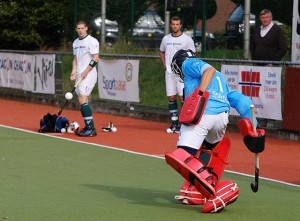
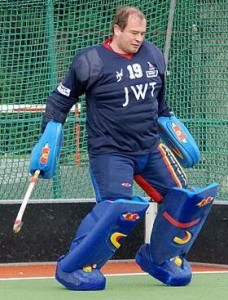
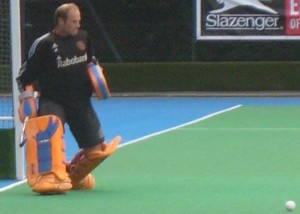
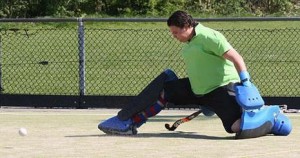
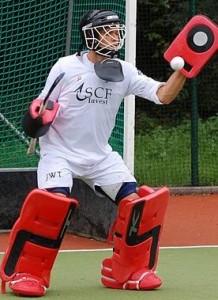
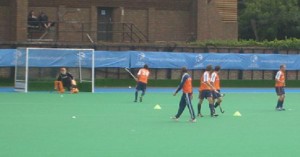
personally beeing a dutch keeper using this method i leave my helmet off even for raised balss durring the warm up, it helps the focus knowing you need to get the balls away. it is more of a risk but if the balls are oushed hard and true by your team mate it is beneficail. you only need a helmet for propper shots and drag fliks
It crazy to even consider warming up without a helmet on. I coach at the English National Champions and the pace the ball is hit at in the National and European Leagues is fierce, but it doesn’t matter what level you play at the ball is harder and faster high or low.
In a multi-ball warm up the ball can deflect off of upper balls up or down and to therefore ‘trust’ to deliver the right balls is expecting too much.
WEAR A HELMET AND THROAT GUARD AT ALL TIMES WHEN FACING A BALL IN A ANY DRILL OR PRACTICE!!!!!!!!!!!!!!!!!!!!!!!
PANDA
another drill i like to do before matches is to remove my gloves (and maybe helmet if it’s too warm) and have someone flick the balls gently to either side for me to catch. i find this very reassuring and i feel that if i can catch and control the ball with the smaller surface of my hands then i should have no problem deflecting with the larger gloves.